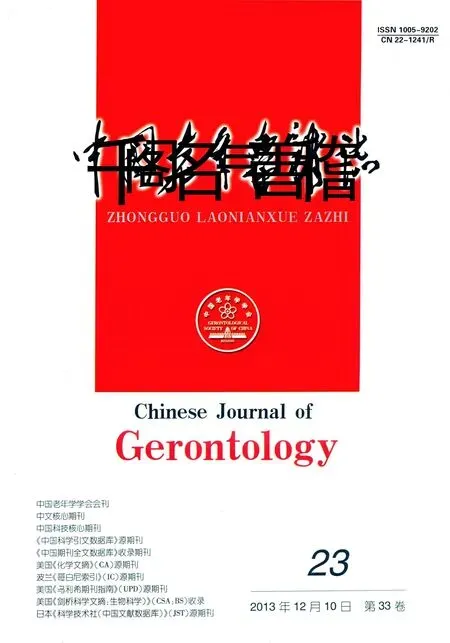前列腺癌诊断模式与发病率的研究进展
阚秀芳 赵丽晶 李 倩 李 浩 王贺彬 赵雪俭
(长春市第二医院体检中心,吉林 长春 130061)
实现早期发现、早期治疗是肿瘤患者延长生命、提高生活质量的关键。美国接受肿瘤治疗的白种人5年生存率最高的是前列腺癌,达99%〔1〕。前列腺癌患者生存率提高与应用血清前列腺特异性抗原(PSA)进行人群筛查,实现早期诊治密切相关〔2〕。
国际肿瘤研究署(IARC)报道,中国前列腺癌发病率1990年为 1.1/105 人/年(PY)〔3〕,2002 年增至 1.6/105 PY〔4〕,在世界上最低;然而死亡率为 1.0/105 PY,病死率(MR:IR)为0.63,居世界最高。2007年 McCracken等〔5〕对长期居住在美国的亚裔人与白种人进行了对比研究,发现华裔美国人的前列腺癌发病率为80.4/105 PY,远远高于中国前列腺癌发病率;死亡率为8.9/105 PY,病死率为0.11,远远低于中国的 0.63。同是中国人,为什么生活在不同国家其前列腺癌的发病率与病死率会存在巨大差别。本文拟探讨产生这种差异的原因。
1 国际前列腺癌发病率、死亡率与流行趋势
2006年Kamangar等〔6〕对1993~2001年全球五大洲八种肿瘤的发病率、死亡率与流行趋势进行了全面的对比研究与评价。在此期间,全球每年有679 060人患前列腺癌,发病率为25.3/105 PY,同期221 036人死于前列腺癌,死亡率为8.2/105 PY,病死率为0.32。其中,北美洲年均发病人数257 943例,发病率为119.9/105 PY,年均死亡人数36 447人,死亡率为15.8%,病死率为0.13;亚洲年均70 317人诊断为前列腺癌,发病率为 4.7/105 PY,死亡人数 40 126人,死亡率为 2.7/105 PY,病死率为0.57,显著高于北美洲(0.13),提示亚洲的前列腺癌患者多为晚期,生存期限低于北美洲。研究表明,局限在前列腺被膜下的早期前列腺癌5年存活率高达100%,而发生广泛转移者5年存活率仅为49%〔7〕。提示前列腺癌早期发现、早期诊治对于提高老龄男性的生存期与生活质量具有重要意义。由于北美洲应用血清PSA对50岁以上男性进行每年一次的PSA筛查,尽管其发病率高达119.9/105 PY,但病死率仅为0.13,提示北美的前列腺癌诊断模式不仅实现了前列腺癌的早期诊治,而且提高了患者的生活质量,延长了生存期。亚洲的病死率达0.57,意味着诊断为前列腺癌的病例半数以上同年死亡,提示亚洲多数前列腺癌病例直到中晚期或已伴有广泛转移时才诊断,失去了最佳的治疗机会。
2 中国前列腺癌的发病率与死亡率
2002年国际肿瘤综合网站上,中国年龄标准化的前列腺癌发病率是1.6/105 PY,因此被认为发病率居世界“最低”〔8〕;但是死亡率为1.0/105 PY,病死率为0.63,高于亚洲的平均水平(0.57),更无法与北美洲(0.13)相比〔6〕。中国发达地区的临床流行病学资料表明,前列腺癌发病率不断提高。上海市前列腺癌的发病率1973 年为1.6/105 PY,2000 年为7.7/105 PY,27年间增长4.8倍〔9〕,跃居男性恶性肿瘤首位。北京大学泌尿外科研究所建所前后50年间,前列腺癌占男性泌尿外科肿瘤的比例呈直线上升趋势,从3.3%上升至13.4%〔10〕。长春市八大医院前列腺癌回顾性调查结果表明,1999~2001年前列腺癌诊断例数是1986~1989年的4.6倍,而且358例患者中C、D期病例占72.4%,仅4例做过根治手术〔11~14〕。上述数字表明,我国前列腺癌极低发的原因与坐等患者的诊断模式密切相关。
3 美国应用血清PSA筛查实现了早期诊治
1983年在Stamey教授的倡导下,Staf地区率先应用血清PSA开展前列腺癌的集团筛查〔15〕。1987~1989年这项措施迅速普及全美国,实现了前列腺癌的早期诊断与早期治疗〔16〕。Kamangar等〔6〕报道的全球五大洲八大肿瘤的研究资料来源于1993~2001年,美国已基本实现了前列腺癌的早期诊断与治疗。此间,前列腺癌的发病率超越肺癌居男性恶性肿瘤的第一位,而死亡率居第二位〔17,18〕。
Stamey等〔16〕发现:(1)前列腺癌根治术前血清PSA含量进行性下降:第一个五年为(24.74±38.0)ng/ml,此后依次降低为(20.01 ±21.61)、(10.22 ±9.05)、(8.14 ±9.70)ng/ml,有力说明PSA人群筛查使美国人群中的中晚期前列腺癌逐渐减少。(2)直肠指诊癌性结节的触及率进行性下降:第一个5年为90.79%,之后逐渐下降至 58.02%、38.54%和 16.76%,充分显示应用PSA进行人群筛查可诊断出传统诊断技术无法诊断的早期前列腺癌,第四个5年如果单纯用触诊和影像学方法会使83.2%的前列腺癌病例漏诊。(3)病理学参数的变化:取根治术后的前列腺癌标本进行每隔3 mm的连续切片,由同一个病理医师做病理学观察结果发现:①癌平均体积指数明显下降,从第一个五年的(5.33 ±6.59)cc,以后依次下降为(4.93 ±5.59)、(3.76 ±4.37)、(2.44 ±3.04)cc;②癌细胞浸润精囊腺的发生率,第一个五年为 23.03%,以后依次降为6.96%、4.74%和5.41%;③癌穿透被膜的深度,第一个五年为(1.54±2.78)cm,以后依次为(1.02 ± 2.32)、(0.57 ± 2.22)、(0.22 ±0.80)cm;④周围淋巴结癌侵袭率,第一个五年为12.5%,以后依次降为 7.17%、4.55%,最后一个五年降为 0.00。
从Stamey等〔19〕的这项回顾性研究可清楚看出,第一个5年间,无论是血清PSA含量、癌性结节的触及率,还是各病理参数都以中晚期前列腺癌为主。这一结果与长春应用PSA筛查12 027名50岁以上男性的结果相近〔14〕。然而在第四个5年,血清 PSA含量降至(8.14±9.70)ng/ml,癌性结节的触及率仅为16.67%,提示83%以上的前列腺癌为早期。Ji等〔20〕将长春市应用血清PSA筛查诊断的前列腺癌分为有影像变化组(58例)和无影像变化组(35例),有影像学变化组A期病例100%被漏诊(24例A期前列腺癌,0诊断);B期病例漏诊率为29.42%(5/17);C期病例漏诊24.0%(6/25);只能准确诊断D期病例。事实上,这些D期病例都是经过PSA人群筛查、超声引导下活检诊断的。Gao等〔21〕对集团筛查诊断前列腺癌的病理学研究发现,长春市PSA>4.0 ng/ml的受检者,超声引导下活检的前列腺癌诊断率为 25.9%,其中 Gleason≥7者占56.2%,Gleason 为8、9 者为17.1%。Li等〔22〕发现,血清 PSA <20 ng/ml的病例中,Gleason≥8的患者外周血单个核细胞表达PSA mRNA的阳性率高达86%,而Gleason≤6的患者中,阳性率为0〔13〕。进一步证明传统诊断方法会漏诊早期前列腺癌,实现前列腺癌的早期诊治必须转变前列腺癌的诊断模式。
4 血清PSA筛查的争议
美国预防服务专责小组(USPSTF)基于以下原因质疑PSA筛查〔23,24〕:(1)PSA筛查对于减少前列腺癌致死率帮助甚微〔25〕。(2)PSA筛查不能特异性诊断高侵袭性前列腺癌,并可能带来心理及生理上的伤害,如过度诊断和过度治疗造成精神损伤;超声引导的前列腺活检可导致血尿或感染;前列腺癌根治术可能引起尿失禁和阳痿〔26〕。
美国前列腺、肺、结肠和卵巢(PLCO)癌症筛查试验研究〔25〕,经7~10年的跟踪观察认为PSA筛查对于减少前列腺癌的死亡帮助很小。而事实上,美国从1987年就开始对50岁以上男性进行年度PSA检查〔27〕,而PLCO的研究1993年才开始〔25〕。美国95%的泌尿科专家认为PSA筛查有用,从而大部分50岁以上男性自愿进行筛查〔27,28〕。欧洲前列腺癌随机筛查研究(ERSPC)仅用血液PSA进行筛查〔29〕。根据9年定期复查,得出PSA筛查降低了20%的前列腺癌致死率,最新报道为21%〔30,31〕。通过以上信息的启发,我们建议 USPSTF重视20年来PSA筛查对于前列腺癌IR、MR和MR∶IR的积极影响。虽然PSA筛查不能改变前列腺癌的病程,但使用PSA筛查可诊断早期的前列腺癌。
Stamey等〔32〕发现在开始筛查的5年,术前血清PSA平均为(24.74 ± 38.08)ng/ml,Gleason 等级为 4/5 的有 30.89%。到第4个 5年期,平均 PSA 降到(8.14±9.70)ng/ml,Gleason等级为4/5的患者有35.03%。说明PSA筛查对于前列腺癌的早期诊断有价值,但不改变PCA的恶性程度。
一些文献表明局限性前列腺癌患者的5年存活率高达99%〔32〕,而广泛转移的患者仅为31%〔33〕。高侵袭性前列腺癌(Gleason分级4/5)早期常发生微小转移。通过前列腺癌病人外周血单核细胞PSA mRNA的表达分析微小转移率,表明PSA为4~20 ng/ml的病人中,Gleason≥8的微小转移率达85.7%,而Gleason≤6的病人几乎不发生微小转移。
此外,为了避免PSA带来的过度诊断和过度治疗,美国癌症协会对PSA<2.5 ng/ml的人检查间隔为2年1次,PSA水平在2.5~4 ng/ml的人每年1次,PSA在4 ng/ml以上的一般推荐做进一步评价或进行前列腺超声引导下前列腺组织活检〔27〕。
5 小结
华裔美国人与本土中国人在前列腺癌发病率和病死率方面出现的巨大差异,与人种和生活习惯无关,与美国在政府强有力的支持下对50岁以上男性每年查一次PSA、实现了前列腺癌的早期发现与早期诊治有关。
1 Ries LAG,Melbert D,Krapcho M,et al.SEER Cancer Statistics Review,1975-2005,National Cancer Institute.Bethesda,MD,http://seer.cancer.gov/csr/1975_2005/,based on November 2007 SEER data submission,posted to the SEER web site,2008.
2 Collin SM,Martin RM,Metcalfe C,et al.Prostate-cancer mortality in the USA and UK in 1975-2004:an ecological study〔J〕.Lancet Oncol,2008;9(5):445-52.
3 Ferlay J.GLO Bocani:cancer Incidence and mortality worldwide〔M〕.Lyon:IARC Press,1998:383-5.
4 Ferlay J,Bray F,Pisani P,et al.Globocan 2002:cancer incidence,mortality and prevalence worldwide.IARC Cancer-Base No 5,version 2.0〔M〕.Lyon:IARC Press,2004:3981-3.
5 McCracken M,Olsen M,Chen MS Jr,et al.Cancer incidence,mortality,and associated risk factors among Asian Americans of Chinese,Filipino,Vietnamese,Korean,and Japanese ethnicities〔J〕.CA Cancer J Clin,2007;57:190-205.
6 Kamangar F,Dores GM,Anderson WF.Patterns of cancer incidence,mortality,and prevalence across five continents:defining priorities to reduce cancer disparities in different geographic regions of the world〔J〕.J Clin Oncol 2006;24:2137-50.
7 Hayat MJ,Howlader N,Reichman ME,et al.Cancer statistics,trends,and multiple primary cancer analyses from the Surveillance,Epidemiology,and EndResults(SEER)Program〔J〕.Oncologist,2007;12(1):20-37.
8 Mettlin C,Jones G,Averette H,et al.Defining and updating the American Cancer Society guidelines for the cancer-related checkup:prostate and endometrial cancers〔J〕.CA Cancer J Clin,1993;43:42-6.
9 Ye DW,Li CL.Epidemiological trends of prostate cancer:retrospect and prospect〔J〕.China Oncol,2007;17:177-80.
10 Gu FL,Liu YL.Changing status of genitourinary cancer in recent 50 years〔J〕.Chin J Urol,2002;23:88-90.
11 Zhang L,Ji GY,Li XM,et al.The influence of mass screening for prostate cancer on the diagnostic status of the clinical prostate cancer〔J〕.Chin J Urol,2004;25:103-4.
12 Li XM,Tsuji I,Kuwahara M,et al.Mass screening of prostate cancer in Changchun city of China〔J〕.Int Urol Nephrol,2004;36:541-8.
13 Kuwahara M,Tochigi T,Kawamura S,et al.Mass screening for prostate cancer:a comparative study in Natori,Japan and Changchun,China〔J〕.Urology,2003;61(1):137-41.
14 Zhang HF,Wang HL,Xu N,et al.Mass screening of 12,027 elderly men for prostate carcinoma by measuring serum prostate specific antigen〔J〕.Chin Med J(Engl),2004;117:67-70.
15 Stamey TA,Yang N,Hay AR,et al.Prostate-specific antigen as a serum marker for adenocarcinoma of the prostate〔J〕.N Engl J Med,1987;317:909-16.
16 Stamey TA,Kabalin JN,McNeal JE,et al.Prostate specific antigen in the diagnosis and treatment of adenocarcinoma of the prostate.Ⅱ.Radical prostatectomy treated patients〔J〕.J Urol,1989;141:1076-83.
17 Mettlin C,Murphy GP,Babaian RJ,et al.The results of a five-year early prostate cancer detection intervention.Investigators of the American Cancer Society National Prostate Cancer Detection Project〔J〕.Cancer,1996;77:150-9.
18 Jemal A,Murray T,Ward E,et al.Cancer statistics 2005〔J〕.CA Cancer J Clin,2005;55:10-30.
19 Stamey TA,Caldwell M,McNeal JE,et al.The prostate specific antigen era in the United States is over for prostate cancer:what happened in the last 20 years〔J〕.J Urol,2004;172(4 Pt 1):1297-301.
20 Ji GY,Zhang L,Zhao W,et al.Transrectal ultrasound-directed prostate biopsy can detect early prostate cancer〔J〕.Chin J Androl,2005;19:22-4,33.
21 Gao HW,Li YL,Wu S,et al.Mass screening of prostate cancer in a Chinese population:the relationship between pathological features of prostate cancer and serum prostate specific antigen〔J〕.Asian J Androl,2005;7:159-63.
22 Li Y,Mao JH,Zhang L,et al.Study on relationship between the expression of PSA mRNA and protein in the mononuclear cells of the peripheral blood and prostate cancer micrometastasis〔J〕.Chin J Androl,2006;20:5-7.
23 McNaughton-Collins MF,Barry MJ.One man at a time--resolving the PSA controversy〔J〕.N Engl J Med,2011;365:1951-3.
24 Schroder FH.Stratifying risk——the U.S.Preventive services task force and prostate-cancer screening〔J〕.N Engl J Med,2011;365:1953-5.
26 Andriole GL,Crawford ED,Grubb RL 3rd,et al.Mortality results from a randomized prostate-cancer screening trial〔J〕.N Engl J Med,2009;360:1310-9.
27 Cancer Advances in Focus.Prostate cancer:National Cancer Institute〔R〕.2010.
28 Smith RA,Cokkinides V,Brooks D,et al.Cancer screening in the U-nited States,2010:a review of current American Cancer Society guidelines and issues in cancer screening〔J〕.CA Cancer J Clin,2010;60:99-119.
29 Draisma G,Etzioni R,Tsodikov A,et al.Lead time and overdiagnosis in prostate-specific antigen screening:importance of methods and context〔J〕.J Natl Cancer Inst,2009;101:374-83.
30 Schroder FH,Hugosson J,Roobol MJ,et al.Screening and prostatecancer mortality in a randomized European study〔J〕.N Engl J Med,2009;360:1320-8.
31 Miller AB.New data on prostate-cancer mortality after PSA screening〔J〕.N Engl J Med,2012;366:1047-8.
32 Stamey TA,Caldwell M,Mc Neal JE,et al.The prostate specific antigen era in the United States is over for prostate cancer:what happened in the last 20 years〔J〕?J Urol,2004;172:1297-301.
33 Collin SM,Martin RM,Metcalfe C,et al.Prostate-cancer mortality in the USA and UK in 1975-2004:an ecological study〔J〕.Lancet Oncol,2008;9:445-52.
34 Jemal A,Siegel R,Xu J,et al.Cancer statistics,2010〔J〕.CA Cancer J Clin,2010;60:277-300.

